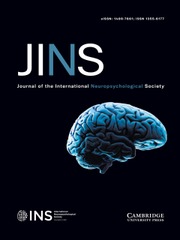No CrossRef data available.
Article contents
Development and validation of the TabCAT-EXAMINER: A tablet-based executive functioning battery for research and clinical trials
Published online by Cambridge University Press: 30 October 2025
Abstract
The National Institutes of Health (NIH) Executive Abilities: Measures and Instruments for Neurobehavioral Evaluation and Research (EXAMINER) is a validated laptop-based battery of executive functioning tests. A modified tablet version of the EXAMINER was developed on the UCSF Tablet-based Cognitive Assessment Tool (TabCAT-EXAMINER). Here we describe the battery and investigate the reliability and validity of a composite score.
A diagnostically heterogeneous sample of 2135 individuals (mean age = 65.58, SD = 16.07), including controls and participants with a variety of neurodegenerative syndromes, completed the TabCAT-EXAMINER. A composite score was developed using confirmatory factor analysis and item response theory. Validity was evaluated via linear regressions that tested associations with neuropsychological tests, demographics, clinical diagnosis, and disease severity. Replicability of cross-sectional results was tested in a separate sample of participants (n = 342) recruited from a frontotemporal dementia study. As this separate sample also collected longitudinal TabCAT-EXAMINER measures, we additionally assessed test-retest reliability and associations between baseline disease severity and changes in TabCAT-EXAMINER scores.
The TabCAT-EXAMINER score was normally distributed, demonstrated high test-retest reliability, and was associated in the expected directions with independent tests of executive functioning, demographics, disease severity, and diagnosis. Greater baseline disease severity was associated with more rapid longitudinal TabCAT-EXAMINER decline.
The TabCAT-EXAMINER is a tablet-based executive functioning battery developed for observational research and clinical trials. Performance can be summarized as a single composite score, and results of this study support its reliability and validity in cognitive aging and neurodegenerative disease cohorts.
Keywords
Information
- Type
- Research Article
- Information
- Journal of the International Neuropsychological Society , Volume 31 , Issue 3 , March 2025 , pp. 242 - 253
- Copyright
- © The Author(s), 2025. Published by Cambridge University Press on behalf of International Neuropsychological Society
Footnotes
Joel Kramer and Adam Staffaroni are co-senior authors.

